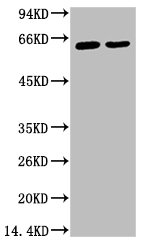![Cytokeratin 6A (KRT6A) (Basal Cell Marker)(rKRT6A/2100), 0.2mg/mL [26628-22-8] Cytokeratin 6A (KRT6A) (Basal Cell Marker)(rKRT6A/2100), 0.2mg/mL [26628-22-8]](https://biotium.com/wp-content/uploads/2021/02/view_image-767.jpeg)
Cytokeratin 6A (KRT6A) (Basal Cell Marker)(rKRT6A/2100), 0.2mg/mL [26628-22-8]
BNUB3799
ApplicationsImmunoHistoChemistry, ImmunoHistoChemistry Paraffin
Product group Antibodies
TargetKRT6A
Overview
- SupplierBiotium
- Product NameCytokeratin 6A (KRT6A) (Basal Cell Marker)(rKRT6A/2100), 0.2mg/mL
- Delivery Days Customer9
- ApplicationsImmunoHistoChemistry, ImmunoHistoChemistry Paraffin
- CertificationResearch Use Only
- ClonalityMonoclonal
- Clone IDrKRT6A/2100
- Concentration0.2 mg/ml
- Gene ID3853
- Target nameKRT6A
- Target descriptionkeratin 6A
- Target synonymsCK-6C, CK-6E, CK6A, CK6C, CK6D, K6A, K6C, K6D, KRT6C, KRT6D, PC3, keratin, type II cytoskeletal 6A, cytokeratin 6A, cytokeratin 6C, cytokeratin 6D, keratin 6A, , type II, keratin 6A, type II, keratin, epidermal type II, K6A, type-II keratin Kb6
- HostMouse
- IsotypeIgG1
- Protein IDP02538
- Protein NameKeratin, type II cytoskeletal 6A
- Scientific DescriptionThis MAb recognizes a protein of 56 kDa, identified as cytokeratin 6A (KRT6A). In humans, multiple isoforms of Cytokeratin 6 (6A-6F), encoded by several highly homologous genes, have distinct tissue expression patterns. Cytokeratin 6A is the dominant form in epithelial tissue. Cytokeratin 6 and 16 are expressed in keratinocytes, which are undergoing rapid turnover in the suprabasal region (also known as hyper-proliferation-related keratins). Cytokeratin 6 is found in hair follicles, suprabasal cells of a variety of internal stratified epithelia, in epidermis, in both normal and hyper-proliferative situations. Epidermal injury results in activation of keratinocytes, which express KRT6 and KRT16. KRT6 is strongly expressed in about 75% of head and neck squamous cell carcinomas. Primary antibodies are available purified, or with a selection of fluorescent CF® Dyes and other labels. CF® Dyes offer exceptional brightness and photostability. Note: Conjugates of blue fluorescent dyes like CF®405S and CF®405M are not recommended for detecting low abundance targets, because blue dyes have lower fluorescence and can give higher non-specific background than other dye colors.
- SourceAnimal
- Storage Instruction2°C to 8°C
- UNSPSC12352203




